In This Article:
- Coronavirus Impact on Crypto Miners
- Coronavirus Impact on Crypto Exchanges
- Coronavirus Impact on Crypto Awareness
- Coronavirus Impact on Crypto Assets

How the Crisis is Affecting Miners and the Bitcoin Hashrate
The first and most obvious impact that this market crash has had is that many of the less efficient Bitcoin miners simply haven’t been able to turn a profit at the current prices, and have begun shutting off their mining rigs. This has led to a drop in hashrate, or the overall amount of computing power being used to secure the network. However, with a significant drop in hashrate there is also a subsequent drop in difficulty, and this of course incentivizes miners to begin coming back online. The result we have seen is an intense increase in the volatility of the Bitcoin hashrate, beginning a couple of weeks after February 24th, when markets began to really slide. At the time of this writing, the difficulty has returned to levels seen above the $8,000 price point, and as you can see from the chart, we are trending back towards averages close to where we were in the months before the crisis. It is possible we will see further stabilization in the hashrate, assuming there are no more major price drops in the short term.
Another way this is affecting miners is that some are diverting their computing power in order to help aid the global effort to find vaccines or therapies for the coronavirus. Some of these miners were no longer seeing a profit, and some just wanted to contribute to the solution to this pandemic. Either way, it is a great example of how the community is responding and adapting in order to be part of the recovery effort.
One of the more immediately impacted sectors of the cryptocurrency community are the larger mining operations which traditionally employ teams of workers to maintain the thousands of rigs running 24/7. Due to mandatory isolation, many of these companies are having a hard time keeping up with maintenance and are beginning to see some of their hashpower decline as a result. While this may or may not be a long-term problem, it could have an impact on the overall hashrate of the network if we don’t see an improvement in the situation soon.
At the time of this writing, the difficulty has returned to levels seen above the $8,000 price point, and as you can see from the chart, we are trending back towards averages close to where we were in the months before the crisis. It is possible we will see further stabilization in the hashrate, assuming there are no more major price drops in the short term.
Another way this is affecting miners is that some are diverting their computing power in order to help aid the global effort to find vaccines or therapies for the coronavirus. Some of these miners were no longer seeing a profit, and some just wanted to contribute to the solution to this pandemic. Either way, it is a great example of how the community is responding and adapting in order to be part of the recovery effort.
One of the more immediately impacted sectors of the cryptocurrency community are the larger mining operations which traditionally employ teams of workers to maintain the thousands of rigs running 24/7. Due to mandatory isolation, many of these companies are having a hard time keeping up with maintenance and are beginning to see some of their hashpower decline as a result. While this may or may not be a long-term problem, it could have an impact on the overall hashrate of the network if we don’t see an improvement in the situation soon.
How the Crisis is Affecting Cryptocurrency Exchanges
The impact that is being seen on cryptocurrency exchanges has varied a bit. Fortunately, many exchanges exist primarily on the internet anyway, and hence can be run without the need for employees in a central office. Recently Coinbase announced various measures their company is taking to keep employees safe, along with the admission that “a lot of credit goes to our internal teams who have built the tooling that allow us to flip the switch during a crisis to work almost 100% remotely.”Thanks to the fact that this is true of most of these platforms, there has been no significant impact on the general operation of these major exchanges, at least from the user side of things. One way that the exchanges have been stepping up behind the scenes is to donate directly to the effort to aid victims of the disease. In January, Binance announced it would be donating $1.5 million to aid in the relief effort, a move that also prompted Huobi to quickly put up a matching donation. They weren’t the only ones however, as in late March Ripple also announced that they would be donating $100,000 each to two different research funds that were studying responses to coronavirus.Coinbase CEO @brian_armstrong shares an update on how we are keeping employees safe and ensuring that we are serving our customers during these trying times. https://t.co/XjLKY4ylfw
— Coinbase (@coinbase) March 20, 2020
One place where markets have been clearly and notably impacted is futures trading. Because of the now high uncertainty in what is to come in both the global economy as well as cryptocurrency, the demand and hence value of Bitcoin futures contracts has seen a notable surge. Recently both CME Group and Bakkt have reported a sizeable boost in the volume of their BTC futures trading, as clearly investors are running to lock in prices against further market drops, and speculators are seeking to profit off of the volatility. Based upon trading patterns, it seems that there is a general sentiment that the price of cryptocurrency will continue to rise amidst this financial turmoil, which is certainly optimistic for the future of the market.In these challenging times, Ripple is committed to being part of the global response to the COVID-19 pandemic. We’re starting in our own backyard with $100K donations each to @tippingpoint's COVID emergency response fund and @siliconvalleycf’s COVID Regional Response Fund. (1/2)
— Ripple (@Ripple) March 25, 2020
How the Crisis is Affecting Cryptocurrency Awareness
When it comes to how both the cryptocurrency community, as well as the public at large, view digital assets during this difficult time, opinions can be split. It is true that when markets began to fall globally, cryptocurrency was no exception. In fact, many described it as a “bloodbath” due to the fact that Bitcoin dropped a full 50% that day. This has led to some serious discussion as to whether cryptocurrency can really convince traditional institutions that it is a solid store of value, given that such fluctuations are still possible.The answer to this question, many feel, comes from the way that this crisis is impacting the value and function of the fiat currency world. For one, the US Federal Reserve has been going into overdrive with economic stimulus, as many central banks are, and as a result are now printing $1 million every second. This stands to drive intense inflation of the US Dollar, which could see investors and regular citizens alike flocking to hedges like Bitcoin and Gold, which should be highly resistant to inflation. It isn’t just the value of money that is at stake here either, it is the very system that handles it. Already there have been multiple bank failures and bailouts in just the early days of this turmoil, and there isn’t a ton of reasons to be optimistic right now. As banking institutions begin to fail, public confidence in that very system could begin to wane, causing people to begin pulling out money en masse. This is called a “bank run,” and due to the very common practice of fractional reserve banking, these institutions don’t actually have enough money on hand to allow everyone to withdraw all at once. If this plays out, it will certainly help make the case for cryptocurrency allowing people to be their own bank, but it remains to be seen if this is how the public will respond. Lastly, there is a very real possibility that this emergency could be a catalyst for the creation of one or more central bank digital currencies (CBDC). A variety of reasons, from the need for an effective means to distribute relief funds, to the concern that paper money is a transmission medium, have helped to increase interest in digital assets as a 21st century means to bring aid to the world. Even before the pandemic, China had been exploring the rollout of a blockchain-based national currency, but it looks like now many other nations are becoming interested. It is debated in cryptocurrency circles if this is actually a good step forward or a perversion of the ideologies inherent to the field, but regardless it seems research is developing.so how the fuck do we convince anyone to ever buy/trade bitcoin again?
— blueberryville.eth (@loomdart) March 13, 2020
it literally went down 50% in one day
The COVID-19 pandemic is accelerating the rise of central bank #digitalcurrencies as many governments see the handling of cash as a potential risk factor. This will likely add to calls to move towards #digitalcash according to our #dbresearch colleague @MarionLaboure pic.twitter.com/TnotaTKouK
— Deutsche Bank (@DeutscheBank) April 3, 2020
How the Crisis is Affecting Specific Assets
Now we will turn our attention to how this financial turmoil has specifically hurt some of the top assets in the cryptocurrency space. Obviously with the hundreds upon hundreds of coins out there, we can’t cover everything, but we will touch on some of the biggest moves for projects with the largest market caps. Furthermore, we will first be looking at the Dow Jones Industrial Average (DJI) and Bitcoin (BTC) so we can see the baseline for how these markets have been doing since February 24th, which is when things started to tumble in general. We will then be looking at other coins and comparing how they have done against both the US Dollar (USD) and BTC. To keep this article from becoming too cluttered, all charts will be displayed just in USD, but it should give you a fine idea of how the prices reacted in general.Dow Jones Industrial Average (DJI)
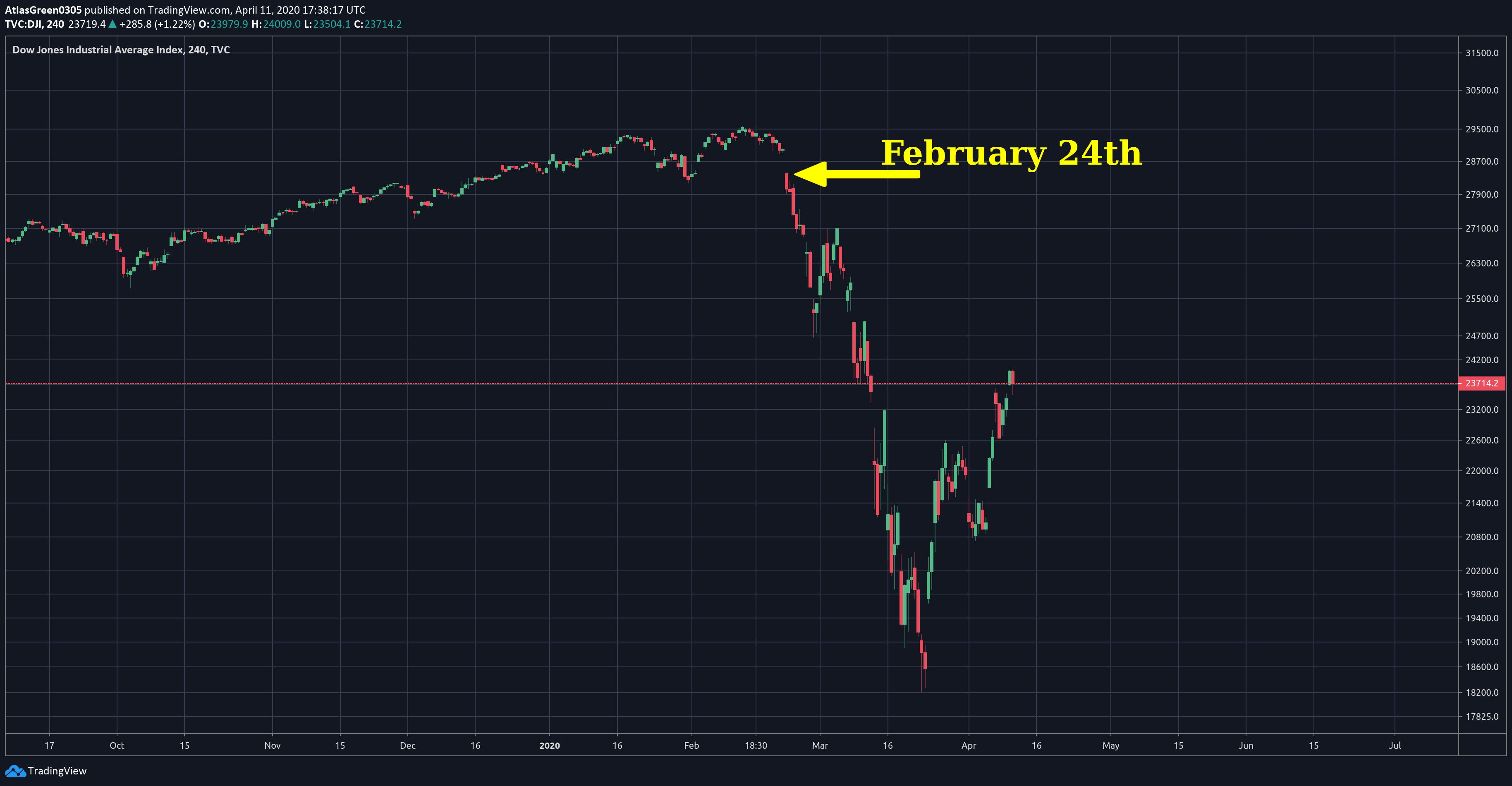 We will be using this as a basis for the downturn in the traditional markets. As you can see, there was a very notable drop after February 24th, which led to a 35% slide in market value in the following days. Since the bottom, there has also been a 30% increase, but obviously future prospects are uncertain and will weigh heavily on both how the pandemic evolves as well as various governmental responses.
We will be using this as a basis for the downturn in the traditional markets. As you can see, there was a very notable drop after February 24th, which led to a 35% slide in market value in the following days. Since the bottom, there has also been a 30% increase, but obviously future prospects are uncertain and will weigh heavily on both how the pandemic evolves as well as various governmental responses.
Bitcoin (BTC)
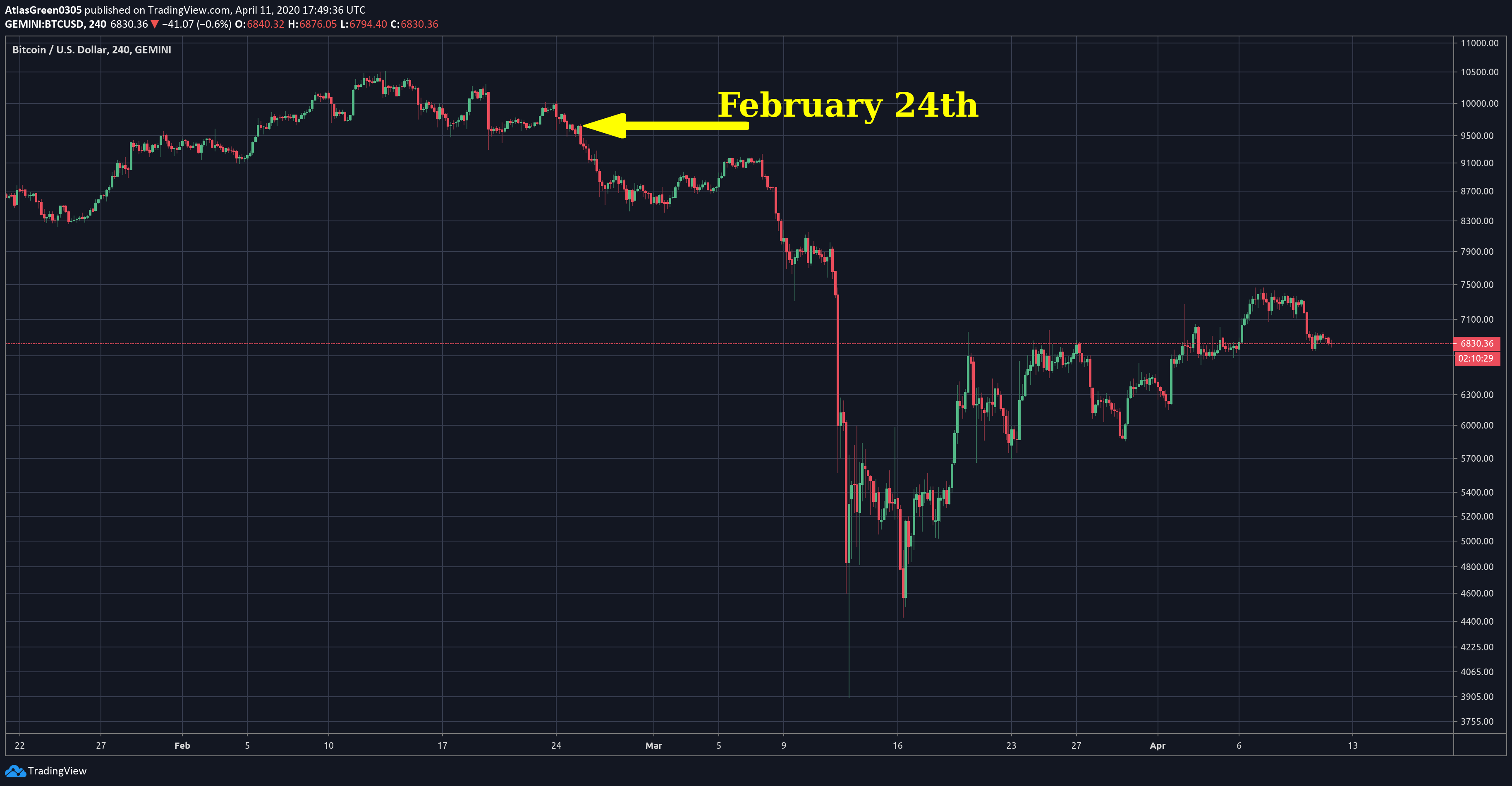 When the market began dropping, Bitcoin was quick to follow suit. Not surprisingly, the impact on this market was even more profound, with a full 60% drop at the bottom of the move. That being said, the market has, at the time of this writing, seen a 75% rise from the lows of this slide. Much like with traditional markets, there is no way to say that this type of rebound will continue, but as for now the technicals on Bitcoin at least are looking promising.
When the market began dropping, Bitcoin was quick to follow suit. Not surprisingly, the impact on this market was even more profound, with a full 60% drop at the bottom of the move. That being said, the market has, at the time of this writing, seen a 75% rise from the lows of this slide. Much like with traditional markets, there is no way to say that this type of rebound will continue, but as for now the technicals on Bitcoin at least are looking promising.
Ethereum (ETH)
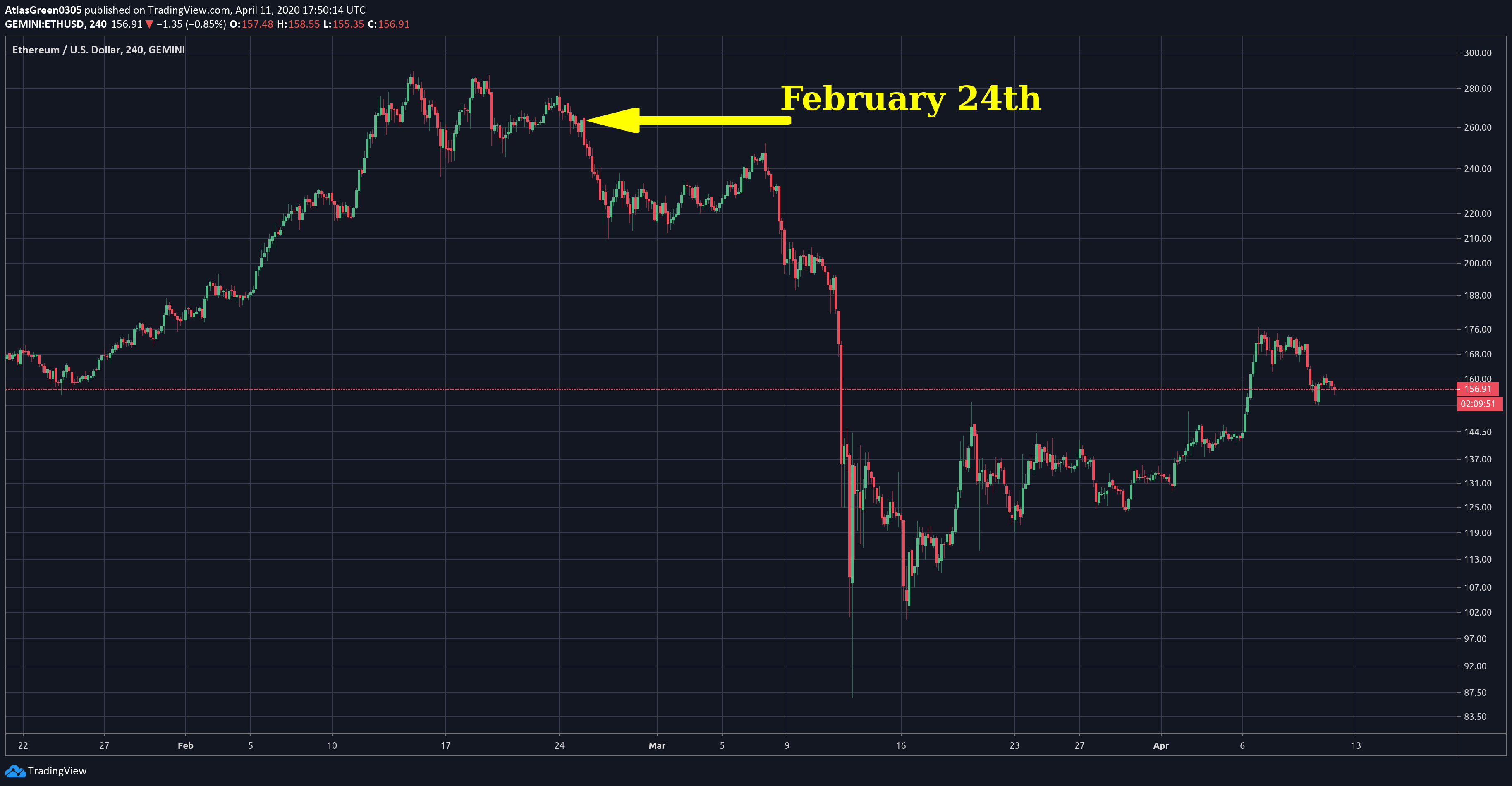 Moving on into Altcoins, Ethereum has definitely seen some major movements amidst this global downturn. The initial drop for the coin saw a full 66% devaluation against USD. This was followed by a similarly dramatic 80% rise, making this among the more volatile responses among major projects. Because they were falling together, there was a relatively modest drop of “only” about 26% against BTC, with a subsequent recovery of 13%.
Moving on into Altcoins, Ethereum has definitely seen some major movements amidst this global downturn. The initial drop for the coin saw a full 66% devaluation against USD. This was followed by a similarly dramatic 80% rise, making this among the more volatile responses among major projects. Because they were falling together, there was a relatively modest drop of “only” about 26% against BTC, with a subsequent recovery of 13%.
XRP
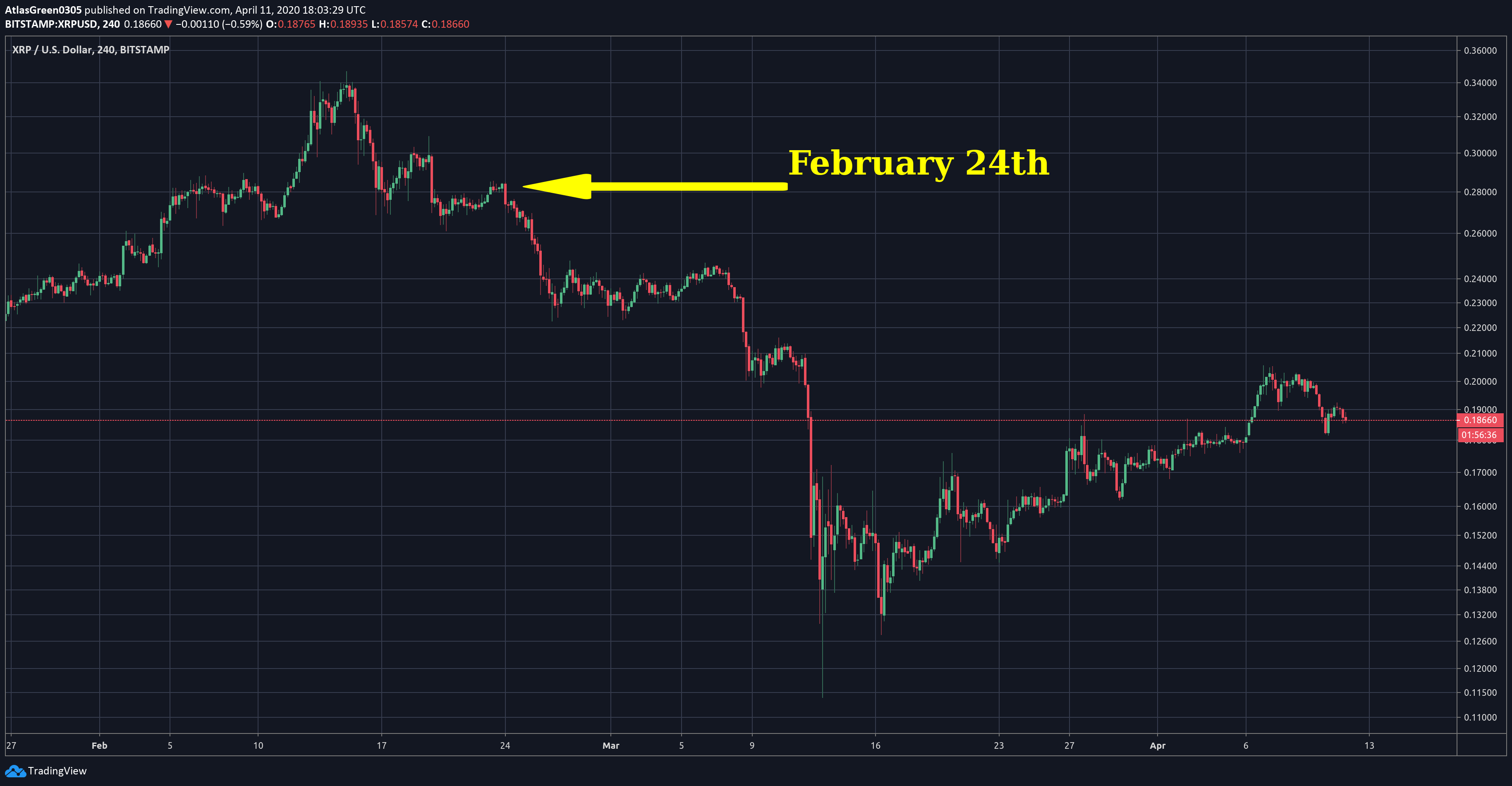 Another major asset that was deeply affected was XRP. With an initial drop along with the rest of the market to the tune of about 60%, but has also seen a roughly 60% rise during its recovery. Against Bitcoin XRP did fairly well, only losing about 16% of its relative value.
Another major asset that was deeply affected was XRP. With an initial drop along with the rest of the market to the tune of about 60%, but has also seen a roughly 60% rise during its recovery. Against Bitcoin XRP did fairly well, only losing about 16% of its relative value.
TRON (TRX)
 TRON is another project that was affected similarly to Ethereum. Here again, we see a substantial initial drop in USD value, maxing out at a 66% loss. Also like many other projects, there has been an impressive recovery period, which in this case was a nice 73%. Against Bitcoin TRON saw a 26% initial slide, but has since come back up by about 15%.
TRON is another project that was affected similarly to Ethereum. Here again, we see a substantial initial drop in USD value, maxing out at a 66% loss. Also like many other projects, there has been an impressive recovery period, which in this case was a nice 73%. Against Bitcoin TRON saw a 26% initial slide, but has since come back up by about 15%.
Monero (XMR)
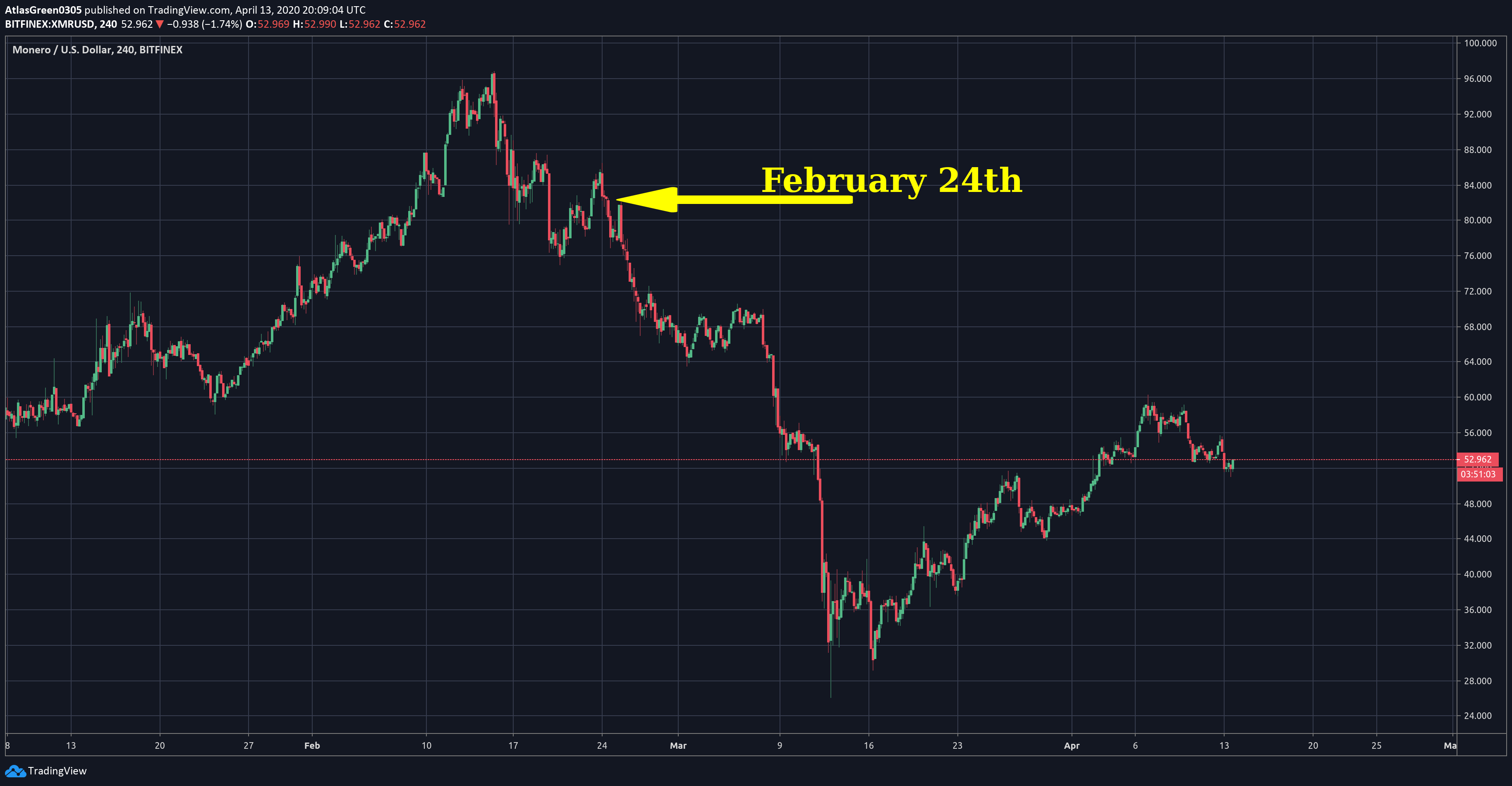 While all coins are feeling the effects of this crisis, some are rebounding better than others. Monero, for example, did see quite a hit, with an initial drop of 68%, however since has recovered a full 105% since hitting bottom. This is likely tied to its use as a privacy coin, a feature that may be increasingly attractive as regulations may plausibly become stricter during a global crisis. Against Bitcoin, Monero initially fell a full 30%, but since then has risen back up by about 26%.
While all coins are feeling the effects of this crisis, some are rebounding better than others. Monero, for example, did see quite a hit, with an initial drop of 68%, however since has recovered a full 105% since hitting bottom. This is likely tied to its use as a privacy coin, a feature that may be increasingly attractive as regulations may plausibly become stricter during a global crisis. Against Bitcoin, Monero initially fell a full 30%, but since then has risen back up by about 26%.
Chainlink (LINK)
 Another coin that has behaved a little different than the rest of the market is Chainlink. While it did slide a bit just after February 24th, it then saw notable upside, though this did eventually give way to losses comparable to much of the market, in the 60% range. This was followed by a very impressive 125% rebound, making Chainlink one of the more profitable returns for those who were able to invest near the recent bottom. Compared to Bitcoin, LINK only dropped about 22%, and has since come back up by about 52%.
Another coin that has behaved a little different than the rest of the market is Chainlink. While it did slide a bit just after February 24th, it then saw notable upside, though this did eventually give way to losses comparable to much of the market, in the 60% range. This was followed by a very impressive 125% rebound, making Chainlink one of the more profitable returns for those who were able to invest near the recent bottom. Compared to Bitcoin, LINK only dropped about 22%, and has since come back up by about 52%.
Conclusion
Of course there are many, many more projects we could analyze, but by now you should be seeing the basic pattern that most assets followed. Some have fared a bit better or worse than their brethren, but no project remained unaffected. At the time of this writing, it is still unclear how the situation will play out even in traditional markets, making cryptocurrency even more of a wildcard. Will the upcoming Bitcoin halving still have the intended effect on the price? Many were debating what kind of resonance this halving would create even before there was a pandemic and financial crisis. This truly seems to be the moment digital assets have been waiting for. It is their chance to prove to the world that they are more than just speculation, but a real commodity that can store value. There’s no way to know if it will pay off just yet, but based on the current market details, there is real hope.Disclaimer
In line with the Trust Project guidelines, the educational content on this website is offered in good faith and for general information purposes only. BeInCrypto prioritizes providing high-quality information, taking the time to research and create informative content for readers. While partners may reward the company with commissions for placements in articles, these commissions do not influence the unbiased, honest, and helpful content creation process. Any action taken by the reader based on this information is strictly at their own risk. Please note that our Terms and Conditions, Privacy Policy, and Disclaimers have been updated.



